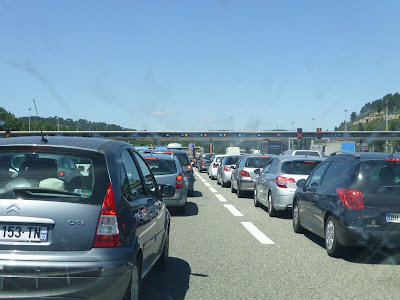Picking a hire car up at Heathrow and heading out into the countryside has been surprisingly easy. We contacted the hire car company from the airport after we had collected our luggage and they picked us up in a shuttle bus and took us to their office nearby. When all the paperwork was completed we loaded up the car and we were on our way.
(We reversed the process when we returned the car. You can then travel into London to Paddington Station on the train if you are finishing your holiday with some time in the city.)
Driving on the big M roads there are speed limits and speed cameras. There is a slow lane largely occupied by big trucks, a the middle lane for faster vehicles and of course the fast lane where the speedsters travel, often faster than the speed limit!
Be wary of white vans , they generally are a menace and are often driven my madmen!
Once you have cleared the heavy traffic of the M25 ring road around London and have moved to the smaller A or B roads driving is fairly stress free and in our experience flows well.
But be warned they become narrow very quickly!
However......
there are lots of single lane roads throughout the UK and if you want to see the countryside you need to wind your way along these pretty roads.
There will be no way you can pass oncoming cars on these roads and you soon learn to keep a watch for small widened sections that are designed for you to pull into in order to allow the oncoming car to get by. The good thing is that the other drivers do the same and take their turn though this often means reversing back to the nearest spot.
All of this is quickly negotiated and on you go with a cheery wave to the other driver. ( Don't forget that, it's important to acknowledge a considerate act !)
Driving down these very narrow, hedgerow lined roads can be very scarey at times.
In places like Cornwall the hedgerow can tower above the road and often hide rock walls that are very unforgiving and the roads twist and turn so you have no clue about the oncoming traffic that can be hurling towards you at speed. All you can do is cross your fingers and pray and stay alert.
TRAFFIC
In the country generally the traffic was sparse, especially during the week.
As soon as you venture into the bigger towns it is a different story and you need to park as soon as you are able and walk. Big cities are generally best avoided, use public transport.
PARKING
You will quickly learn that if you park, you have to pay - even at some supermarket parking areas.
On the outskirts of popular tourist villages there are huge parking areas - a testament to the large volume of tourists that visit.( Cotswolds, Stratford-on-Avon).
Be wary of time limits and expiry times as parking wardens are often very active. ( especially in Windsor where luckily we were forewarned but other unlucky tourists weren't !)
Be wary of time limits and expiry times as parking wardens are often very active. ( especially in Windsor where luckily we were forewarned but other unlucky tourists weren't !)
There are many villages whose streets are too narrow to allow parking anyway so park and walk in is the only way to go.( especially in Cornwall )
Large busy towns like Oxford and Cambridge have a system Park and Ride areas set aside outside the towns where you park your car and catch a bus into the city as there is NO parking available anywhere.
The locals move around on hundreds of push bikes.





















